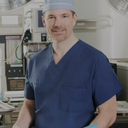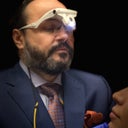Your issue, missing the required images to confirm, might well be a case of the so-called cleavage tenting, a complication that may occur if not preoperatively diagnosed and prevented. I am not saying your surgeon is to blame on this, it is sometimes very very difficult to predict this eventuality, even for the most experienced surgeons.Some definitions:-symmastia: is a total fusion of breasts, which run continuous without any cleavage gap; this may be a congenital feature or a consequence of breast augmentation; if breast implants are involved it is a condition the implants touch each other to tag a case as iatrogenic (medical cause) symmastia; some cases may be close-to symmastia when the implants are very near to touch each other at the cleavage-tenting: this is not a congenital issue, but it is indeed congenitally conditioned; nobody is born with tenting at the cleavage, but there has to exist a congenital weakness of the medial cleavage ligaments and/or very poor adhesion of the skin to the sternum bone; as result of the former any forward pull of the breast skin may perform a poorly constrained traction of the cleavage skin, lifting the pre-sternum skin and separting it from the bone, thus making a "tent" and creating a fake effect of symmastia, without implants or breast tissue in contact between breastsWhich factors are required to develop tenting? the following:-weakness of the ligaments of the cleavage and non-firm fixation of the skin to the sternum-broad implants, paraogically well chosen, into a perfect fit to fill up the cleavage and aiming to optimize a beautiful result-more likely with the patient wishes large increases of the breast, so the forward skin pull is strongerHow to prevent it?:-preoperatively the cleavage area has to be assessed, normally few surgeons accomplish this test, touching, pinching out and stressing the firmness of the cleavage skin and ligaments; even though... it is not always possible to predict a potential tenting risk; in my opinion and with vast experience, if you are meticulous you can predict 90% of cases in risk of tenting (and subsequently apply counter measures); however... this is like a diabolic situation: an optimal result and well chosen implants may produce tenting if the patient has underlying risk factors... and preventing tenting requires sacrificing beauty and achieven suboptimal or poor results in terms of cleavage fullness... and this is difficult to accept and understand by some patients, also hard to follow for some surgeons-once the tenting risk is detected preoperatively the strategy is clear: if you use wide and optimized implants you have to reduce the anterior pull by using flat (low profile) implants... this may be extremely dissapointing for the patient since she'll be unable to achieve the expected breast size (small breasts is the outcome); or alternatively you can use narrow bases and compensate the volumen with a strong skin pull using highly projected (moderate, high or very high profile; as a rule of thumb: the more projected the implant the stronger the pull >>> therefore the narrower must be the base to decrease the pull and the tenting risk; trick and tip for my dear colleagues) implants... however this may lead to highly dissatisfactory empty cleavage and a wide gap between breast; anyhow, and based on patient's preferences, the former or the latter strategy HAS TO be applied if you wish to prevent a tenting scenario in a patient with underlying tenting risk; in a normal case (vast majority) the surgeon can and must choos the widest implant fitting into the breast and as projected as the patient wishes to increase the size of it, however on a tenting risk case either the width or the projection (or a bit of both) of the implant has to be sacrificed for safety reasonsWhat is the treatment once it has happened, due to misdiagnosed conditions or unpredictable cleavage behaviour? Two strategies, not incompatible between them, arise:-using narrower and/or less projected implants and let the strain pull on the skin be reduced and the cleavage spontaneously settle back on the sternum-perform (or add to the former) a medial cleavage multipoint capsulorrhaphy to secure and reattach skin to the bone; this is recommended when: tenting evolved into a higher or lesser grade of real symmastia (may happen overtime in some tenting cases), there is a fear the skin (very loose and flaccid cases) might not return to the sternum, and / or the patient wishes to broaden the implants base or increase their projection (size) or bothYou may wonder: why not performing a cautionary capsulorrhaphy in primary cases in which the tenting risk is detected, thus allowing the use of implants with the required width and the projection wished by patient? The answer is complex (not complicated or difficult) and covers a multifactorial cause: adds a high cost, surgical time and pain to patients, most patients prefer to sacrifice a bit of cleavage and/or projection and go through a routinary procedure rather than a challenging one, few surgeons have experience and mastery performing capsulorrhaphies (not my case, as revision surgeon I have to use quite regularly this technique), etc. In my personal experience: I always check the cleavage preoperatively in search for any tenting risk signs, if detected I alert the patient and negotiate with her which of the three strategy I have to follow:-80% opt for keeping size and projection but sacrificing cleavage, choosing slightly narrower implants base, to obtain a wider cleavage-20% prefer a well close cleavage and accept sacrificing projection and size-0%, no one ever after more 3000 breast augmentations in my career, has ever opted to perform a cautionary capsulorrhapy to maintain optimal width and chosen projection of implantsAnd yes, a few cases in my career I could not predict accurately the behaviour of the cleavage and my patient developed a tenting, this is unavoidable even in the best hands, and needless to say I know how to fix that... and I fixed them; in my revision mammoplasty series of experience I'd say 70% cases are due to poor judgement from the surgeon, misdiagonosis or just careless approach to the case (even oversized bases or overdissected pockets) and 30% non-attributable to surgeon's skills for being unpredictable, but of course this is my sesies as receptor of hundreds of revision cases, there is a bias; in good hands and experienced surgeons the risk of developing tenting due to a careless or misdiagnosed approach is null, and the risk of an unpredictable (in spite of good diagnosis) cleavage skin behaviour is extremely low, infinitessimal.









